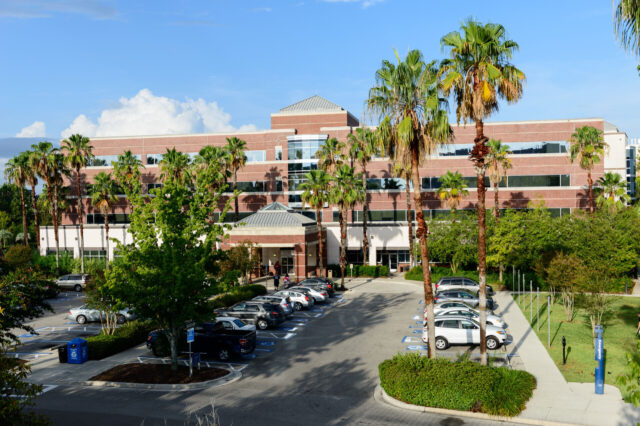Choosing UF Health for prostate cancer treatment
UF Health’s expert prostate cancer doctors work as a multidisciplinary team to provide comprehensive care that is personalized for each one of our patients. From leading-edge treatment options to traditional care methods, we offer diverse options to treat prostate cancer for patients across Florida.
Your UF Health prostate cancer team that includes urologic surgeons, medical oncologists, radiation oncologists and pathologists, works with you to develop the best course of action. We aim to keep your goals and preferences in mind.
Depending on the grade and stage of your cancer, as well as your overall health, treatment may include:
- Active surveillance
- Chemotherapy
- Combination of multiple treatment types
- Conventional and proton radiation therapies
- Focal therapy, such as cryotherapy or high-intensity frequency ultrasound (HIFU)
- Hormonal therapy
- Immunotherapy
- Proton therapy
- Robotic surgery
- Combination of multiple treatment types
Additionally, our prostate cancer team at UF Health actively participates in the latest clinical trials and are a part of new discoveries that advance the field of prostate cancer care.
What is prostate cancer?
Prostate cancer is a type of cancer that occurs in the prostate gland, which is a small gland in men that produces seminal fluid. The prostate gland is anatomically situated between the bladder and urethra and as such is also closely involved with urinary control. While prostate cancer can be a serious disease, early detection and treatment normally leads to successful outcomes and long-term survival.
What are the causes and risk factors of prostate cancer?
About 1 in 8 men in the U.S. will be diagnosed with prostate cancer in their lifetime.
Prostate cancer tends to occur most commonly in men over the age of 50, and greater than 65% of all cases are diagnosed in men 65 years and older. The incidence of prostate cancer increases with age. Well-established risk factors include:
- Older age: The average age of men when they are first diagnosed is about 66.
- Family history: Especially multiple first-degree male relatives who were diagnosed with prostate cancer at a younger age.
- Race: African Americans are at greater risk of developing prostate cancer as compared to other races and often at an earlier age and with higher grade cancers.
- Genetic mutations and syndromes:
- BRCA1 or BRCA2 gene mutations especially gene mutation 2, which are associated with breast and ovarian cancers, can also increase the risk of developing prostate cancer in men.
- Patients with the inheritable condition called Lynch syndrome. or hereditary non-polyposis colorectal cancer, are at risk of many cancers, including prostate cancer in men.
- Geography: Prostate cancer is most common in North America, northwestern Europe, Australia and on the Caribbean islands.
Other potential risk factors thought to be associated with prostate cancer include a diet high in saturated fat and obesity.
What are the signs and symptoms of prostate cancer?
For most men, prostate cancer does not cause symptoms but is detected because of an elevation in prostate specific antigen, or PSA. Largely due to the widespread use of PSA tests, most prostate cancers are now diagnosed at an earlier stage and younger age compared to 20 years ago.
As prostate cancer grows, it may cause the following symptoms:
- Difficulty and discomfort urinating, called dysuria
- Weak urine flow
- Blood in the urine, called hematuria
- Blood in the Semen, called hematospermia
- Frequent urination
- Erectile dysfunction
- Pain in the hips, back, or chest
Other uncommon symptoms of prostate cancer can include urinary retention, weight loss, abdominal pain, bone pain or fracture.
How is prostate cancer diagnosed?
After taking a detailed medical history and performing a physical examination, including a digital rectal exam, or DRE, a PSA blood test will be performed. If the PSA level is elevated, or if the urologist feels a lump during a DRE, a prostate biopsy will be recommended.
The biopsy is an outpatient procedure, meaning you go home the same day, and is performed with local anesthesia. Several samples of tissue are collected from the prostate. These samples are what tell us if you have prostate cancer, and how aggressive it is. If the biopsy is positive, other tests may be performed based on your PSA level, cancer grade and findings on exam. Most commonly, a CT scan of the abdomen and pelvis will be obtained for clinical staging. In high-risk cases, a bone scan may be recommended to determine if there has been spread to the bones.
There are two main types of prostate biopsies that UF Health offers:
Transrectal biopsy: This is the most common type of biopsy. The doctor inserts a thin needle through the rectum and into the prostate gland to collect tissue samples. The procedure is usually done under local anesthesia, and the patient may feel some discomfort.
Transperineal biopsy: In this type of biopsy, the needle is inserted through the skin between the scrotum and the anus. This type of biopsy may be recommended if a patient has had a previous biopsy that did not detect cancer, but the PSA level remains elevated. It may also be recommended for patients who are at a higher risk for complications from a transrectal biopsy. Hear from our patient in the below story for his experience with getting a transperineal biopsy.
Both types of biopsies are generally safe and have a low risk of complications, such as infection or bleeding. However, as with any medical procedure, there are some risks. Patients should discuss the risks and benefits of the biopsy with their doctor before the procedure.
What types of prostate cancer are there?
The overwhelming majority of prostate cancers are adenocarcinomas. These arise from the glandular (acinar) component of the prostate.
Other rare and atypical types of prostate cancer include:
- Ductal carcinoma
- Mucinous carcinoma
- Signet-ring cell carcinoma
- Small cell carcinoma
- Clear cell adenocarcinoma
- Giant cell carcinoma
These rare and atypical variants often act aggressively and may respond differently to therapy than the more common prostate adenocarcinoma. As they are rare, however, most men are unaffected by these atypical variants.
Prostate cancer has changed significantly over the past two decades.Most prostate cancers are now diagnosed in patients at an earlier stage and younger age compared with 20 years ago. This is largely because of the widespread evaluation of prostate specific antigen, or PSA, levels. Clinical staging is performed with a physical exam and abdominal and pelvic CT scan. In cases of advanced or high-risk disease, additional testing such as a bone scan may be necessary.
The prognosis of prostate cancer is directly linked to the stage of disease. Staging is a process that demonstrates how far the cancer has spread. Both treatment options and outlook for prostate cancer depend significantly on the stage of disease.
Local prostate cancer
Approximately 90% of prostate cancers are diagnosed at a localized stage. This means that the cancer is confined to the prostate without evidence of spread. Localized cancers are most commonly detected through an elevation in PSA without causing symptoms.
Less commonly, prostate cancer may be detected by an abnormal digital rectal exam (DRE) or due to urinary symptoms. These may include blood in the urine or problems with urination. Not all local prostate cancers are the same. Some will not cause problems while others are clinically significant and require treatment.
Even among clinically significant cancers, there are differences that further separate cancers by risk. For example, low, intermediate and high-risk prostate cancer. Factors that determine the risk and clinical significance of prostate cancer include:
Following treatment, approximately 15% to 25% of patients with early-stage, or localized, prostate cancer experience a recurrence, indicating possible need for additional therapy. However, the overall 5-year survival for patients with localized prostate cancer is close to 100%.
Advanced prostate cancer
About 10% of prostate cancers are diagnosed at an advanced stage. This means that there is involvement of surrounding structures, spread to lymph nodes or metastasis to distant sites. Advanced prostate cancer causes some symptoms, such as blood in the urine, urinary obstruction or bone pain.
Treatment options for patients with metastatic prostate cancer are more limited, although in some settings, surgery or radiation therapy may still be indicated. More commonly, androgen deprivation therapy, or ADT, also known as hormone therapy, is used to control metastatic disease and slow the growth of more advanced prostate cancers. Chemotherapy may also be used to manage patients with metastatic prostate cancer, although it is not a mainstay of management.
Common sites of metastatic spread include the bone, liver and lungs. The overall 5-year survival for regionally advanced and metastatic prostate cancer is approximately 32%.
At UF Health, we have a multidisciplinary team to treat our prostate cancer patients. Medical oncologists work with our urologists, pathologists and radiation oncologists to manage individualized treatment plans for all of our prostate cancer patients.
What are the treatment options for prostate cancer?
There are several effective treatment options for men with clinically significant localized prostate cancer.
Other than active surveillance, treatments for men with localized prostate cancer include:
Radical prostatectomy: This is the most common surgical treatment for prostate cancer. It involves the removal of the entire prostate gland and some surrounding tissue. The surgery can be performed using open surgery, laparoscopic surgery, or robotic-assisted surgery. Radical prostatectomy can cure many cases of localized prostate cancer, but it can have side effects such as urinary incontinence and erectile dysfunction.
Focal therapy: Focal therapy is a newer approach to treating localized prostate cancer. It involves targeting only the part of the prostate gland that contains cancer, rather than removing the entire gland. This approach can reduce the risk of side effects. At the UF Health, patients are followed with novel urinary biomarkers, imaging and biopsy 6-12 months following focal therapy to ensure successful treatment.
- High-intensity focused ultrasound, or HIFU: HIFU, a type of focal therapy, uses high-energy sound waves to heat and destroy cancer cells in the prostate gland. HIFU can be performed as an outpatient procedure, and it can be a good option for men who are not good candidates for surgery or radiation therapy.
- Cryotherapy: Cryotherapy, also called cryoablation, involves freezing the prostate gland to destroy cancer cells. It is also considered a focal therapy. It can be performed using ultrasound to guide the placement of cryoprobes, which freeze and thaw the prostate tissue. Cryotherapy is an option for men who are not good candidates for surgery or radiation therapy.
Robotic prostatectomy: Robotic prostatectomy is a type of laparoscopic surgery that uses a robot to assist the surgeon. The robot provides better visualization and greater precision during surgery. This can reduce the risk of side effects such as urinary incontinence and erectile dysfunction.
Radiation Therapy: Radiation therapy is a common treatment option for localized prostate cancer. There are multiple types of radiation therapy used to treat prostate cancer:
Treatment recommendations are usually made based on a number of factors, including disease characteristics, risk category, candidacy for a particular treatment and patient preference.
In some cases, low and intermediate-risk prostate cancer, for example, a single treatment may be enough to treat the cancer. For others, particularly in high-risk prostate cancer, a combination of treatments may be required. For low-risk prostate cancer and among older men, active-surveillance is another management option.
Although effective in cancer control, most prostate cancer treatments carry some risk of impacting urinary, sexual and bowel health. Newer treatment methods, however, continue to be developed to minimize the risks of these side effects, such as nerve-sparing radical prostatectomy and focal therapy.
Most prostate cancers are localized and can be treated with surgery, external radiation therapy or interstitial brachytherapy. In low-risk disease, observation or active surveillance may also be an option. Focal therapy using ablative technology is less common and is currently under investigation.
How to prevent prostate cancer
There is no guaranteed way to prevent prostate cancer, but there are some things you can do to reduce your risk:
- Eat a healthy diet that is low in fat and high in fruits and vegetables.
- Exercise regularly.
- Maintain a healthy weight.
If you have any concerns, talk to your doctor about a prostate cancer screening. Screening may include a prostate-specific antigen (PSA) blood test and a digital rectal exam (DRE). Men normally start prostate screening around age 50. For men who have a family history of prostate cancer or are African American, screening should start at age 40.










